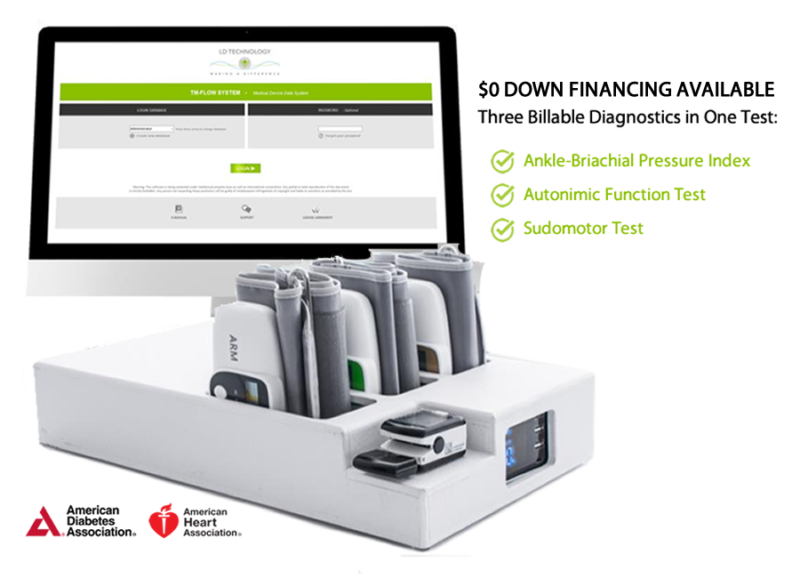Frequently Asked Questions
The TM Flow device offers numerous benefits for medical practices, including non-invasive and accurate testing, early detection of autonomic and arterial dysfunctions, and comprehensive diagnostics that reduce the overall cost of patient care. Additionally, the device’s tests are easy to bill with multi-code diagnostics, making it a valuable investment for enhancing patient care and optimizing practice efficiency. It also supports compliance with standards of care recommended by leading health organizations.
Yes, the TM Flow device is covered by Medicare and most private pay carriers. Specific CPT codes, such as 95921 for cardiovagal innervation and 93923 for ankle-brachial pressure index, ensure that the diagnostics are easy to bill. Coverage and reimbursements may vary depending on the Medicare locality, but the comprehensive diagnostics offered by the TM Flow device are widely recognized and supported by insurance providers.
Autonomic nervous system testing is crucial for diabetes and cardiovascular patients because it helps in the early detection of autonomic neuropathy, which is a common complication in these conditions. Early detection through ANS testing allows for timely intervention and management, reducing the risk of further complications. The American Diabetes Association recommends ANS testing as a standard of care for patients with Type 1 and Type 2 diabetes, highlighting its importance in effective diabetes management.
The TM Flow device is an advanced, non-invasive diagnostic tool designed to perform a series of tests that aid in the identification and early detection of autonomic nervous system (ANS) and arterial dysfunctions. It provides quantitative assessments of the ANS, helping to distinguish between early and late stages of autonomic neuropathy. The TM Flow device is particularly valuable for cardiovascular and diabetic autonomic neuropathy (DAN) testing, making it an essential tool in diabetes management and cardiovascular assessments.

TM Flow in Madison
The TM Flow is being utilized by Madison, WI family practices. This noninvasive, point-of-care method for early detection of neuropathy has been used over 10,000 times by thousands of doctors. The test takes less than fifteen minutes and most insurance policies are now covering the test. The TM flow has been used over 10,000 times by thousands of doctors. Madison Family Practice is the first to use TM Flow in their daily patient care. Thermography testing is getting reimbursed by insurance in family practices. Tilt table tests are less effective than Sudomotor testing for diagnosing Neuropathy. Sudomotor testing is a simple, 14 minutes process that can help diagnose Peripheral Neuropathy
Takeaway: It’s easier than ever to start using Sudomotor testing to better diagnose your patients!
The TM Flow is a noninvasive, point-of-care method for early detection of neuropathy.
The TM Flow is a noninvasive, point-of-care method for early detection of neuropathy. In addition to detecting early signs of diabetic peripheral neuropathy, it can also help detect other types of nerve damage such as compression syndromes, mononeuropathies (single nerves), and multiple mononeuropathies (multiple nerves). A nerve conduction study is currently the gold standard test for diagnosing diabetic peripheral neuropathy; however, it can only be performed in specialized labs by trained technicians. The TM Flow device allows healthcare providers to measure sensory and motor responses at their offices with minimal training required. This means that patients who are most at risk for developing peripheral nervous system diseases now have access to a more accessible test than ever before!
The test takes less than fifteen minutes and most insurance policies are now covering the test.
The TM Flow is a simple blood test that can be done in the doctor’s office and most insurance policies are now covering it. It takes less than 15 minutes to perform and most insurance plans, including Medicare and Medicaid, will pay for the test with no co-pay. If you have health insurance coverage through your employer or through an HMO plan, ask your provider if they offer this blood test.
The TM flow is not covered by all types of medical insurance plans but there are many that do cover it!
The TM flow has been used over 10,000 times by thousands of doctors.
The TM Flow is a non-invasive, point-of-care method for early detection of neuropathy. The test takes less than fifteen minutes and most insurance policies are now covering the test.
The TM Flow has been used over 10,000 times by thousands of doctors across the country to help their patients identify whether or not they may have peripheral nerve damage due to diabetes or other conditions.
Madison Family Practice is the first to use TM Flow in their daily patient care.
Madison Family Practice is the first to use TM Flow in their daily patient care. They’ve been using it for several months now, and have seen a large number of patients who would otherwise not have been on the radar due to their overall good health.
“TM Flow is a noninvasive, point-of-care method for early detection of neuropathy,” says Dr. John Amato, founder of Madison Family Practice and one of the first neurologists to adopt this technology. “I can confidently say that my office sees at least one person per week with symptoms related to diabetes or poor circulation that we could have picked up sooner if they had undergone TM Flow prior.”
Thermography testing is getting reimbursed by insurance in family practices.
Thermography testing is an important part of the TM Flow’s diagnostic process. While MRI and X-rays are great for diagnosing acute injuries, they don’t reveal much about the underlying causes. Thermography can tell you whether your patient has neuropathy—which is a common cause of chronic pain—and what type it is. It’s quick and simple: all you need to do is take a picture (or video) of your patient’s skin with a thermometer, then analyze it on your computer screen or smartphone app.
As you’d expect from such an easy test, it’s covered by most insurance policies. And since it helps diagnose patients better than any other method at this point in time, this is good news for everyone involved!
Tilt table tests are less effective than Sudomotor testing for diagnosing Neuropathy.
One of the most common tests used to diagnose Peripheral Neuropathy is the Tilt table test. This test requires a patient to lie down and be tilted back at an angle of 60 degrees, at which time they will have their legs raised above their head. The idea behind this is that it helps mimic conditions of high altitude, which can cause symptoms similar to those associated with Peripheral Neuropathy.
However, this procedure can be uncomfortable for some patients (especially those with anxiety or fear), and the results from tilt table testing aren’t always accurate in detecting peripheral nerve damage. For example, in one study conducted by Dr. Jerome Jankowski at the Mayo Clinic Scottsdale Arizona over 7 years ago it was found that 17 out of 20 patients who were diagnosed as having PN using Tilt Table testing actually had no evidence of PN when tested using Sudomotor Testing (Sudonomotor Testing is another method for diagnosing PN).
Sudomotor testing is a simple, 14 minutes process that can help diagnose Peripheral Neuropathy.
The TM Flow is a noninvasive, point-of-care method for early detection of neuropathy. The test takes less than fifteen minutes and most insurance policies are now covering the test.
Sudomotor testing is a simple, 14 minutes process that can help diagnose Peripheral Neuropathy. The UMN has been using this test to help patients identify signs of peripheral neuropathy before they become a major problem and treat it accordingly.
Peripheral Neuropathy affects over 20 million people in the US with incidence rates on the rise.
Peripheral Neuropathy is a condition characterized by pain, numbness, and tingling in the hands or feet. It affects over twenty million people in the US with incidence rates on the rise.
Peripheral neuropathy symptoms include:
- Numbness, tingling and/or burning sensations in hands or feet
- Weakness or lack of muscle coordination in hands and arms
- Pain that may be described as shooting, burning or stabbing (located mainly in hands or feet)
Causes of peripheral neuropathy are related to diabetes mellitus (type 1 or type 2), which accounts for 90% of all cases; alcoholism; vitamin deficiencies such as B12 deficiency; metabolic disorders such as kidney disease; thyroid conditions like Grave’s Disease; autoimmune disorders like lupus
To diagnose peripheral neuropathy you need to go through a process similar to any other medical condition–your doctor will ask about your symptoms and conduct a physical exam where they test motor function. If it seems likely that you have this condition then an electrodiagnostic study can help confirm it. Treatment options for peripheral neuropathy include medications for pain relief (called analgesics) such as ibuprofen (Advil®), morphine sulfate patches worn on the skin outside of clothes and nerve block injections directly into areas affected by damaged nerves
It’s easier than ever to start using Sudomotor testing to better diagnose your patients!
TM Flow is a noninvasive, point-of-care method for early detection of neuropathy. The test takes less than fifteen minutes and most insurance policies are now covering the test.
The TM Flow has been used over 10,000 times by thousands of doctors worldwide with no adverse effect reported so far. It’s easier than ever to start using Sudomotor testing to better diagnose your patients!
Conclusion
Thermography testing is growing in popularity as more and more family practices begin to use it. The TM Flow is a noninvasive examination, which means it can be performed quickly in your office and doesn’t require any special equipment or setup time. This makes it an ideal choice for busy practices looking to add a new test option without adding more time or expenses into their daily workflow. The thermographic technique has been proven effective at detecting neuropathy early on, before patients experience symptoms such as numbness or tingling sensations around their feet or hands – which makes this test especially valuable for those who might not recognize that something’s wrong until it’s too late!
RSS FEED
- The TM Flow is a highly reimbursable diagnostic in Portland, OR
- Pain Clinics in Albuquerque, NM Adopt the TM Flow as Gold Standard
- Neuropathy in Philadelphia, PA can be detected with the TM Flow device
- Pain Management Clinics in Dallas, TX are Using the TM Flow to Diagnose Symptoms
- Unlocking the Potential of ANS Testing: Insights for Healthcare Providers
- Neuropathy clinics in Savanah, GA use the TM Flow
- Come to Charleston, WV to Get a TM Flow
- How the TM Flow will maximize your physician practice in Boise Idaho
- Doctors in Pittsburg, PA are using the TM Flow for the treatment of neuropathy
- Which Patients Require ANS Testing?
